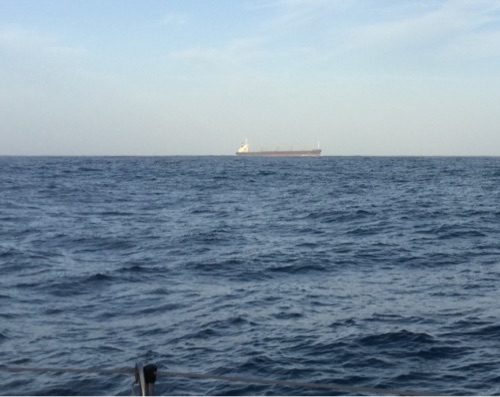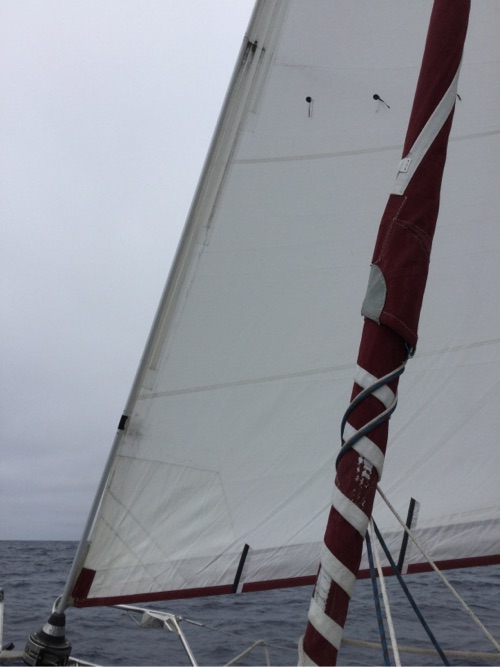Mike Underwood




Thursday 10th August 2017
Deepest thanks to Icom America - specifically to Dwayne Black who kindly enabled a replacement tuner (AT140) and control cable for my SSB/HF M801E radio to be provided, to ex-Brit Kevin who took a time carefully checking over my old tuner in detail, trying to find a faulty component.... and to cheerful, helpful Mary who made sure everything ran smoothly.
Many thanks also to my ham radio friend Eric, WA7LNH, who was my 'chauffeur' for the day - collecting me from the marina to take me in to Icom America's headquarters in Kirkland, not too far from Everett. Eric, a keen ham radio operator (and DX-er), was as interested as I was to see the radio museum displays in the relatively new and very pleasant HQ building before we left to return to 'Nereida' with the new tuner.
Eric was one of the USA 'hams' that I first made contact with on 16th February 2017 when I was passing well south of S. Africa as I made my way east through the Southern Ocean, eventually heading back to Victoria to complete my solo nonstop circumnavigation - and I was in radio contact with at least him and/or others daily for the remaining five months of that journey! Without those contacts, that voyage would have been far more lonely and difficult. Another bonus of having the radio was that, when my computers both became useless, the ham radio community came to my rescue and enabled 'emails' via voice contact - 1,000 emails were dealt with over two months - that was great!
I'm looking forward to installing the tuner but a slight hiccup lies in a slightly different connector needed to make that happen but that's a minor problem and one which will be sorted out within a few days. although I clearly can't use the radio in the meantime. So thanks to XGate for enabling me to use an Aurora terminal to send this update via the Iridium satellite network while underway. (Actually, another radio friend, Walt KM6MQ, was recently very generous in giving me a back up tuner when I stopped overnight in Los Angeles. I must find the time now to look at that in detail to see how to connect it up. It's not an automatic tuner, like the Icom AT140/141, but a good one nonetheless. No point in having back ups on board if I don't know how to make use of them!)
Friday 11th August From Everett to Port Townsend - AP is back working again!!
Having looked over the Commissioning instructions for the malfunctioning autopilot units last night, I saw that it was possible that the problem I had during our approach overnight to Cape Flattery might have been a passing glitch which might be easily fixed - so I changed back to the original autopilot motor and drive unit, hoping that it might work. To my delight, when I tested it out on leaving Everett this morning.... it did!! Yippee!!
It's a bright sunny day, although there's a bank of sea-fog ahead as we head up Admiralty Inlet around midday, enjoying a good ebb tide which is boosting our speed past long, convoluted Whidbey Island.
I'm hoping the fog might lift by the time we reach it or, at least, be thin - but, if not, radar works well to 'see' other boats and land around and the plotter shows vessels on AIS and we transmit to them - so we can stay pretty safe!
ETA Pt Townsend is early afternoon so I'll be able to pick up a couple of boat items I've had sent there, browse around the hardware store for a few other boat items and also meet some friends later on.
Tomorrow, we'll make for Friday Harbor, always a pleasant stop on San Juan Island.

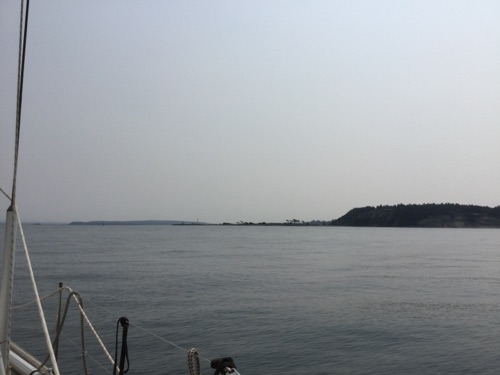


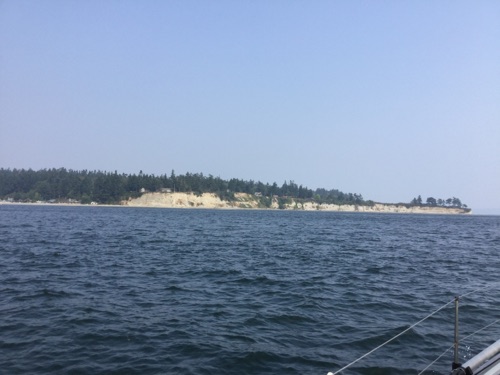

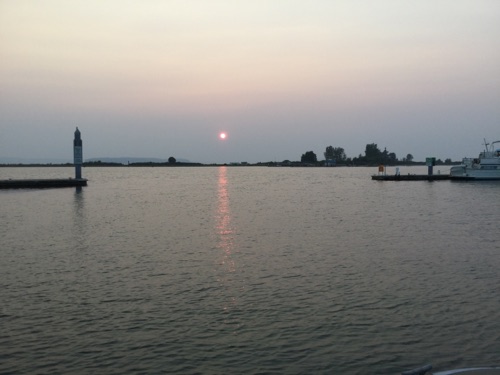

Wednesday 9th August 2017 Excellent speed made, carrying the flood most of today....
No fog today, which was good news - but a lot of blue smoke haze at the end of today's trip due to the ongoing forest fires in B.C. and Washington state.
I knew the journey from Pt Angeles to Everett (just N of Seattle on the mainland) was going to be tiring and I timed it to make best use of the favourable flood tide but, even so, I was surprised at just how strong the tide was a lot of the time - and tried to position us to take best advantage of it, watching the water surface to see where there was the strongest current. As a result, we were often really quick over the ground with speeds of 8-9 kt- with a good 2-3 kt being due to the tide.
Surprisingly, being peak holiday season, there were very few boats seen on the water and we often had Puget Sound to ourselves - apart from the occasional white and green Washington State ferryboats with their distinctive shape and the many black and white murres and murrelets which abounded - often in rafts of up to a hundred on the water, quickly diving when we got close. The San Juan Islands make a lovely cruising ground for sailing boats, with plenty of anchorages and marinas to choose from - but the many shoal areas and strong tidal currents must be treated with caution.
The 60 mile trip was fairly straightforward so long as I stayed close to the helm to keep us on course (tying off the wheel only works for a very short time when under motor and the strong, often swirling, tidal flow added to the problem) so I was feeling very tired by the end of the eleven hours it took. (I hate to think how long it might have taken without the tide advantage.) Once this has been written and posted, I'm about to cook a fast easy meal of ham and eggs, accompanied by a Tecate light beer I just found, and hit my bunk a.s.a.p.!!
I took photos today which I'll post separately as being simpler for me to do... The long Dungeness Spit ending with its light house, as we left the large harbour of Port Angeles this morning; the large red buoy at the end of the same spit, with lots of cormorants flying off as we got close; Point Wilson near to Port Townsend;views of long Whidbey Island; finally, ...smoke haze gives beautiful sunsets - seen from the Everett dock, soon after arrival tonight.
Thanks to the unknown Brit on a sailing yacht I accosted, who helped me, over VHF, to find my way to the marina tonight - chart and reality didn't match up, with a large US Navy repair facility not helping, and I was totally confused!
Tuesday 8th August 2017 - Stll no sight of Vancouver Island through the fog
Late in the afternoon, on the approach to Pt Angeles, we gained from a flood tide - giving up to 7.5kt SOG - an excellent speed for a change!
Radar had been essential to avoid the small sport fishing boats and, even then, twice I found one of them appearing nearby but I hadn't spotted them beforehand - worrying! If I concentrated on the radar screen, I couldn't also concentrate on steering well enough - so we'd veer off course. Fog is very disorientating!
I had tied a line to the wheel in an effort to tie it down when we seemed to be keeping a good course - that worked quite well and allowed me to try to do something else (like check the nearby shipping lanes ... or the radar screen for tiny blobs indicting those small boats) - but eventually we'd always veer off. I still had to stay close by and couldn't afford to leave the helm for any length of time. Our course became a major wiggle!
The Pacific swell gets a long way into the Strait - near to Pt Angeles, it was still a good 2m/6ft but fairly well spaced apart. The car ferry between Pt Angeles and Victoria to the north is often badly affected and has a reputation for rolling about like mad when the swell gets up.
We managed to reach the marina fuel dock just before the attendant closed for the day - but my joy turned to disbelief when I heard the price - I should have filled up completely in Neah Bay - they'd increased the price here massively since last year!!

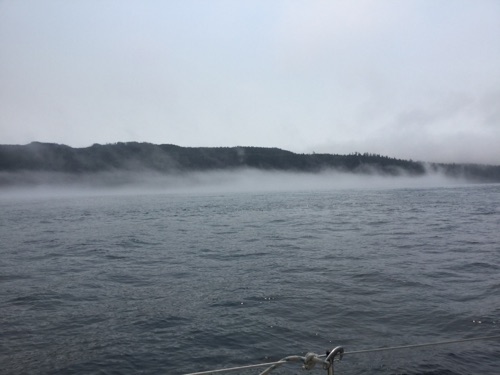
Monday 7th August 2017 Fuel and an overnight stay in Neah Bay, Makah Marina
With both autopilots down and no wind, it was a slow finish with hand steering needed to get to Cape Flattery and on to Neah Bay - often in thick fog.
The good news was carrying the flood tide up to and around Cape Flattery - we made excellent speed past Tatoosh Island, which houses the Cape Flattery light, in calm conditions but with a noticeable current trying first to take us inshore and then towards Duncan Rock and its associated shallows. I managed to keep us well away from those, helped by having been made only too aware of the strong current last time I came by this way - a useful piece of knowledge.
Other highlights of Monday's arrival in the Strait of Juan de Fuca and Neah Bay:
Thick fog patches - strong wind dispersing some fog near land - sunny at times - fishing boat appeared unexpectedly close by in the fog
Turned boat in tight circles while getting fenders and lines on both sides - no AP use to make things simple but space enough.
Usual strong S wind in Neah Bay - impossible to tie up to fuel dock downwind - strong ebb current there adding to wind problem - waited and just managed to tie up, with help, on shorter upwind side.
No response from Marina office - so tied up with difficulty to commercial dock - but was then asked to move. Wind still strong so made sure I got help to tie up to new slip - needed it! (Plenty of strong fishermen around!)
Enjoyed 1) short, deep sleep 2) lovely hot shower 3) fillet and onions etc etc...
Planned tomorrow's journey - difficult long passage to Pt Angeles, probably foggy, at least to start with, to fill up with diesel - price far better there but I now have enough spare diesel in tank to push motor hard if needed.
Up at 6am hoping to arrive before dark - a 15-hr journey, hand steering the entire way....
Hope to post photos separately while underway tomorrow...
Monday 7th August I'm sitting in the cockpit under the shelter of the spray hood as I write this because I'm constantly having to be at the helm to keep us on course - we've no wind to sail under wind-steering and no functioning autopilot. We had several hours of sailing yesterday in good wind although not on our preferred course so, from the time the wind died around midnight, we've been motoring almost due N. At one point I had to call the US Coast Guard to call the fishing vessel 'Raven' on my behalf because they were on clear collision course and not answering my VHF call. They eventually passed just a few hundred yards off, having assured us all that they would 'keep clear'...! Another fishing boat kept well away soon after - they would have heard the exchanges so knew I was close-hauled under sail in fickle wind conditions just then... In fact, a short time later, the wind had died and veered enough to have to turn on the motor again to keep heading N , rather than get too close inshore - this is a very rocky coast! The autopilot (AP) that has been in use so much of this year decided it had had enough of working hard and reliably and suddenly last night the message was displayed: "motor stalled" and I was soon unable to persuade it to work. I was getting tired, it was dark and cold and the air was wet with fog droplets... and there were several ships not far away to keep an eye on (TG for AIS & radar!). I was not a 'happy bunny'! As soon as it was safe to do so, I put us into 'drift mode' and went below to change over to my back-up AP, blessing the fact that I had it and it was so easy to do.... Changed over the drive ram connections to the steering quadrant arm and changed the electrical connections. It worked fine on 'Auto' after I resolved a small problem with rebooting the system (and it wanted calibrating, which clearly was not going to happen just then!) .... It refused to keep us 'on track' but was fine just steering on a heading ... No problem - I could live with that! Unfortunately, that didn't last long and around dawn, luckily after I'd had a couple of decent naps, I realized the AP was not driving the rudder anymore - for whatever reason, it was not in control at all. Rebooting didn't help, the electrical connections all seemed fine.... So here I am having to be close to the helm and keeping a constant eye on our heading. I've rigged up a line to tie off the wheel but we keep drifting off course, no matter how carefully I fine tune it... The ever-changing tidal current affects our heading... Passing Cape Alava as I write this at 10am, I'm relieved I placed a waypoint on the plotter well away from the off-lying rocks which suddenly appeared out of the far mist - looking rather nasty.. The current is clearly trying to take us inshore and I'm having to adjust our heading every few minutes. I'm thankful the AP failure didn't happen earlier on this trip from San Francisco (nearly seven days) - we're twelve miles S of Cape Flattery now and about six hours from the fuel dock at Neah Bay. I'll try to grab something to eat...
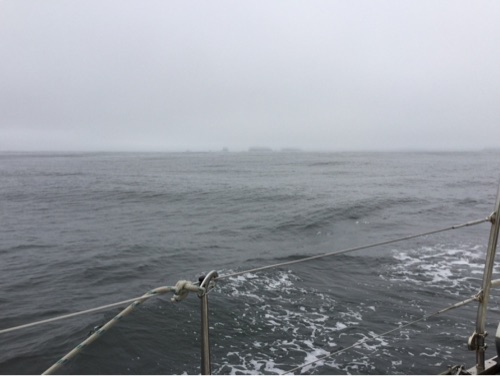

Sunday 6th August 2017
It's been grey, cold and dismal all day, with lumpy seas later on knocking us about. No sunshine!
Winds were fairly light until early afternoon, so we made reasonable progress under motor directly towards Cape Flattery, waiting for the wind to increase, as forecast...
The highlight of the day has been finally getting sailing, with the motor turned off, although we've had to bear off the wind & come away from our rhumb-line course towards the Strait of Juan de Fuca to get up a decent speed. Even now, the wind is gusty and seems to have veered more to the N (which, of course, is near our preferred direction!). As a result, we're headed towards the coast just S of Cape Johnson, well over 30 miles S of Flattery.
As we get closer, the wind could well change direction and, if one forecast is correct, it might die right down, so we could end up motoring again. If the wind doesn't die down, we'll just have to tack away out to sea again.
Being so much closer inshore, just over 20 miles off, has the disadvantage of being more in traffic. Just now, there are six big ships within 18 miles of us - and that's not counting any smaller fishing vessels that are not transmitting on AIS - there were several of those offshore last night. I might not get much sleep tonight....
It's nice to see the Superwind wind generator working well now - despite navigation lights and instruments etc I'm generally seeing a net charge into the batteries - without a lot of noise. There had been a simple bad connection that was attended to in SF.
10 p.m. A lull in the wind - dropped to 11 kt, now up to 14-16kt again. Boat speed suffers when that happens - it's varying a lot. Maybe the wind has already started to die?
Saturday 5th August 2017 - Full sail and good speed - for a time.....! Grey overcast all day today with a couple of small breaks in the cloud showing blue sky near sunset.q Came across a couple of small, commercial, white fishing boats this morning. Difficult to see them against the grey sky and sea - first one was quite close before I spotted it and the other came up at speed soon after. They probably saw Nereida on their AIS but they were not transmitting so I was not aware of them until we were close. Being well offshore, over 60 miles, they would be on the lookout for big ships while fishing so unlikely not to be equipped with an AIS receiver for their own safety. 3.30 p.m. Wind has died and veered again - down to 6 kt and more northerly. With full sail earlier, including staysail, I was very happy to see our speed up around 6 kt for quite a time, close hauled in wind of 10 kt from W-WNW - a vast improvement on the dismally slow speeds of yesterday, albeit with motor still helping to give a good apparent wind. If wind dies any more, I'll have to furl in the genoa and motor upwind to maintain best course.... Might do that anyway - all depends on how well the genoa will hold the wind - presently heading 20 degrees off course to maintain better speed - I don't want to keep on this course for too long. If I had all the time in the world, it would be easy - just drift around, tacking and making best northerly course possible under sail alone. But I'm well behind in my timing to have boat ready for Sept, having expected to get to B.C. by mid-July, if not earlier, so I want to push on north as fast as possible, making good use of this unusually benign weather window. Presently 60 ml W of Cape Meares and Cape Lookout, not far S of Tillamook, and 180 ml from C. Flattery. Experimented..... With headsail furled in and on course: speed (SOG) ~4.3kt. By heading a massive 60 degrees off to starboard of our rhumbline course, SOG finally reached 5kt - but the unfurled genoa was still not filling properly (wind had dropped to 4kt) - mainsail was doing the work. So genoa was furled in and we got back on course. Looking at new weather files, the two are more in agreement for wind from here to Cape Flattery - light NNW now until Sun afternoon, then 10-12 kt or so, NW becoming NNW, until after midnight, getting lighter from W until midday Mon, strengthening from W over Mon afternoon. To take advantage of the increased wind expected from NW-NNW over Sun/Mon, by getting a better angle to sail, given that wind direction, I've changed our course to just W of N for half the distance. (Adding just 5miles to our theoretical total .... 178 ml instead of 173 ml). All subject to change, of course!

Early Saturday 5th August 2017 A dilemma - weather forecasts contradict each other!!
I’m using both the COAMPS and NDFD forecasts, downloaded as attachments to email subscriptions from Saildocs, (Thanks to Jim Corenman and Stan Honey for generously organising that possibility as a free Sailmail service to all sailors!)
Since we’re running less than 100 miles off the coast, the US Navy’s COAMPS forecasts should be the more reliable since they take land effects into account. When available, the new NOAA NDFD forecasts are now generally more reliable for offshore than the GFS grib files, since they come from the daily weather forecasts produced by humans, not solely from computer programs, although I can’t say I’ve had a major problem recently with the GFS files. I get the impression that the NDFD files are possibly better near the coast than the GFS - but I’ve not been able to test my theory that much.
My problem now lies with the major discrepancy on my route between the two programs I’ve been using (COAMPS & NDFD) in a day’s time. They agree on what to expect for the coming 24 hrs or so, but then diverge completely after that - the one showing calm conditions near the coast for the following two days and the other showing strong winds spreading right in to the coast instead…
The problem is that my plan of action will be totally different for the two scenarios… In the one case, just keep on as we are now, in the other, head more offshore to position us to take advantage of the strong wind to sail back in … I’ve even noted the line where it would be good to tack around, assuming the forecast strong wind direction is correct… But there’s no point in adding miles by heading offshore if the wind is not then strong enough to make it worthwhile sailing back towards the coast… or, even worse, if there is then no wind to sail in!
I can only hope that over the coming day, the two are more in agreement on what to expect on Sunday and Monday.
